Mixed signals in the U.S. housing market
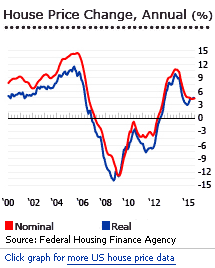 Housing demand is rising in the U.S., but house price-rises are slowing. Why this seeming contradiction? The answer is simple: increased housing supply and more new-builds are coming onto the market, so demand pressures can more easily be met.
Housing demand is rising in the U.S., but house price-rises are slowing. Why this seeming contradiction? The answer is simple: increased housing supply and more new-builds are coming onto the market, so demand pressures can more easily be met.
House prices aren´t rising as fast as they were. The annual increase of 4.26% y-o-y in the first quarter 2015 in the S&P/Case-Shiller seasonally-adjusted national home price index (4.34% in real terms) was the lowest since Q3 2012. There was a 4.39% price rise during the year to May 2015 (4.43% in real terms).
A slowdown is also suggested by Federal Housing Finance Agency (FHFA) figures, with a 4.96% y-o-y rise in the seasonally-adjusted purchase-only U.S. house price index (5.03% in real terms). The index rose by 1.32% q-o-q (1.88% in real terms) during the latest quarter, Q1 2015.
Most tellingly, the median sales price of new homes sold in the U.S. actually fell by 1.8% during the year to June 2015, to US$ 281,800, according to the U.S. Census Bureau.
Yet demand has been shooting up. New house sales rose by 18.1% during the year to June 2015, according to the U.S. Census Bureau. Most sales transactions were in the South (58.5% of all houses sold), according to the U.S. National Association of Realtors.
The U.S. home builder sentiment in July 2015 was at 60, according to the National Association of Home Builders (NAHB)/Wells Fargo Housing Market Index (HMI) - the highest level since November 2005.
“The fact that builder confidence has returned to levels not seen since 2005 shows that housing continues to improve at a steady pace,” according to NAHB Chairman Tom Woods. A reading of 50 is the midpoint between positive and negative sentiment.
New privately-owned housing unit starts were up by 26.6% y-o-y to June 2015, while housing completions increased by 22%, according to the U.S. Census Bureau.
Not surprisingly, forecasters expect US housing prices to continue rising in 2015. CoreLogic projects a 5% to 6% increase in its national home price index. The Zillow Home Price Expectations Survey expects U.S. home values to increase by an average 4.4% in 2015. Barclays Bank predicts 3% to 4% growth in 2015. The bank sees tighter credit conditions and higher mortgage interest rates, as factors that could limit the appreciation of home prices.
More residential construction
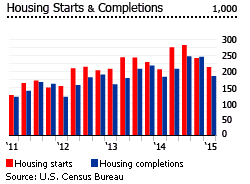
"The primary reason that house price gains are set to slow further is the loosening in housing supply conditions," according to Paul Diggle of Capital Economics.
Privately-owned housing unit building permits rose around 30% y-o-y to June 2015 to 1,343,000 units. New privately-owned housing starts rose 26.6%, housing completions were up 22%, according to the U.S. Census Bureau.
The average supply was around 5 months, a slight decline from 5.1 months in May 2015, according to the NAR. "Local officials in recent years have rightly authorized permits for new apartment construction, but more needs to be done for condominiums and single-family homes," according NAR’s chief economist Lawrence Yun.
From 1990 to 2007, total housing completions averaged 1.5 million units per year. However due to the global crisis, housing completions fell to 1.1 million units in 2008, 794,400 units in 2009, 651,700 units in 2010 and 584,900 units in 2011. The number of completions showed improvement in 2012, rising by 10.9% from the previous year to 649,000 units. By 2014 completions were back at 884,000 units.
Foreclosures continue to fall
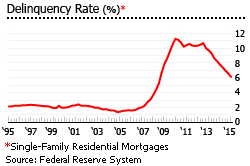
The delinquency rate on single-family residential mortgages fell to 6.14% in Q1 2015, the lowest rate since Q4 2008, based on the figures from the U.S. Fed. Distressed homes, i.e., foreclosures and short sales sold at discount prices, dropped to 8% of total sales in June 2015 from 11% the previous year. Foreclosures were around 6% of total June 2015 sales, with short sales 2%, according to the NAR.
“U.S. foreclosure starts have not only returned to pre-housing crisis levels, they have fallen well below those pre-crisis levels and are still searching for a floor, down 4% from a year ago,” according to RealtyTrac’s vice president Daren Blomquist.
The improving labour market has helped borrowers “stay current on their mortgage loan”, says CoreLogic’s chief economist, Frank Nothaft.
Despite that, foreclosures were up in eight of the country’s 20 largest metros during the first half of 2015: Boston (29%), St. Louis (25%), New York (24%), Houston (19%), Dallas (19%), Detroit (13%), Philadelphia (8%), and Baltimore (5%).
Rising housing sales
All regions had increases in sales during the year to June 2015. The highest increase was in the South, where homes sold rose by 23.7%. In the Northeast, houses sold rose by 23.1%, followed by the West (10.9%) and the Midwest (5.7%).
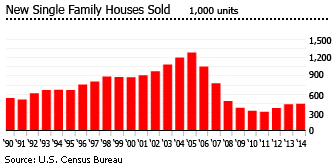
The total existing-home sales, including single family and condo units, rose by 9.6% during the year to June 2015.
"Buyers have come back in force, leading to the strongest past two months in sales since early 2007," according to National Association of Realtors’ (NAR) chief economist Lawrence Yun. Stable job growth and an improving economy are boosted demand, Yun added.
Some big cities are still seeing strong price-rises
Most of the U.S.’s 20 major cities are still experiencing relatively strong house price hikes, though less than in 2013, with Denver posting the highest y-o-y increase of around 10% in May 2015. It was followed by San Francisco (9.7%), Dallas (8.4%), Miami (8%), Seattle (7.4%), Portland (7.4%), Las Vegas (6.7%), Tampa (6.4%), and Los Angeles (6.1%).
During the U.S. housing boom (1996-Q1 2006), all 20 main U.S. cities experienced spectacular house price rises. Los Angeles registered the biggest house price rise of 265.5%, followed by San Diego (247.7%), San Francisco (226.6%), and Miami (213.1%).
In Q2 2006, house prices started to fall. From Q2 2006 to Q4 2011, the S&P/Case-Shiller composite-20 home price index plunged 33.8%. Of the twenty largest U.S. metro areas, Phoenix registered the biggest drop (-55.2%), followed by Miami (-50.5%), Detroit (-42.8%), San Francisco (-41%), Los Angeles (-40.7%), and San Diego (-39.7%).
Starting the second half of 2012, the U.S. housing market started to recover, led by Phoenix. In 2012, Phoenix house prices rose by 23% from a year earlier, followed by Detroit (15.2%), San Francisco (14.4%), Las Vegas (12.9%), and Minneapolis (12.1%). All of the 20 largest cities in the U.S., except New York, saw house price rises in 2012 from a year earlier. The U.S. housing market grew stronger in 2013, with Las Vegas registering the biggest annual house price increase of 25.5%, followed by San Francisco (22.6%) and Los Angeles (20.3%). During 2014 house prices started to slow, which has continued in the first half of 2015. In 2014, the S&P/Case-Shiller composite-20 home price index rose by 4.4% from a year earlier, lower than 13.4% y-o-y growth in 2013.
HOUSE PRICE CHANGE (%) |
||||||
| US CITIES | Housing boom (Jan 1996 – Mar 2006) | Housing crash, global crisis (Apr 2006 – Dec 2011) | 2012 | 2013 | 2014 | May-15 |
| (y-o-y) | (y-o-y) | (y-o-y) | (y-o-y) | |||
| New York | 172.58% | -24.45% | -0.28% | 6.17% | 1.84% | 2.95% |
| Los Angeles | 265.49% | -40.06% | 10.17% | 20.30% | 5.50% | 6.13% |
| Chicago | 96.84% | -33.47% | 2.22% | 11.26% | 1.27% | 2.24% |
| Phoenix | 182.59% | -54.73% | 22.98% | 15.28% | 2.36% | 3.84% |
| San Diego | 247.66% | -39.68% | 9.23% | 17.99% | 4.95% | 4.84% |
| Dallas | - | -7.53% | 6.48% | 10.23% | 7.51% | 8.44% |
| San Francisco | 226.59% | -40.82% | 14.39% | 22.62% | 9.38% | 9.71% |
| Detroit | 71.99% | -43.31% | 15.16% | 16.59% | 2.42% | 3.88% |
| Boston | 152.49% | -16.38% | 3.55% | 9.65% | 3.74% | 2.25% |
| Seattle | 134.22% | -23.97% | 8.21% | 12.40% | 6.54% | 7.41% |
| Composite-10 | 192.25% | -33.52% | 6.03% | 13.54% | 4.26% | 4.68% |
| Composite-20 | - | -33.31% | 6.94% | 13.38% | 4.41% | 4.94% |
| Source: S&P | ||||||
The Pacific region had the highest house price increases (8.43%) during the year to May 2015, followed by the Mountain region (7.81%) and the South Atlantic region (6.84%), according to the FHFA.
Other regions: West South Central (6.37%), East North Central (5.17%), East South Central (4.95%), West North Central (4.55%), New England (2.03%), and Middle Atlantic (0.89%).
Interest rates remain super-low

The U.S. Fed’s key interest rate was 0.13% in July 2015, slightly up on 0.09% in July 2014. The Fed Funds target rate has been 0%-0.25% since December 2008. and can hardly fall further, and an interest rate hike is expected soon.
Cheaper mortgages continue to fuel housing demand. Based on the figures released by Freddie Mac, average interest rates for fixed mortgages were even lower this year than last year:
- The average interest rate for 30-year fixed rate mortgages (FRMs) fell to 4.05% in July 2015 from 4.13% a year earlier.
- The average rate for 15-year FRMs dropped to 3.21% during the same period, from 3.24% in July 2014.
- The average rate for 5-year adjustable rate mortgages (ARMs) declined to 2.96% in July 2015 from 2.99% last year.
- The average rate for 1-year ARMs rose to 2.52% in July 2015, from 2.39% in July 2014.
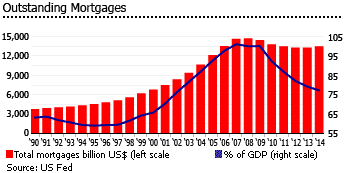
Despite lower rates, the U.S. mortgage market has been shrinking. In 2014, the size of the mortgage market was equivalent to 77.2% of GDP, down from 79.2% of GDP in a year earlier, and also a sharp drop from 100.1% of GDP in 2009, based on the figures from the U.S. Federal Reserve System.
Rents are rising, vacancy rates are falling

Rising rents are another sign of the increasingly healthy economy The median asking rent rose by 6.2% to US$ 803 per month during the year to the second quarter of 2015, according to the U.S. Census Bureau.
- In the Northeast, the median asking rent rose sharply by 12.3% during the year to Q2 2015, to US$ 1,044 per month.
- In the Midwest, the median asking rent rose by 7.1% y-o-y to US$ 692 per month in Q2 2015.
- In the South, the median asking rent was up by 6.3% y-o-y to US$ 765 per month in Q2 2015.
- In the West, the median asking rent rose by only 2% y-o-y, to US$ 928 in Q2 2015.
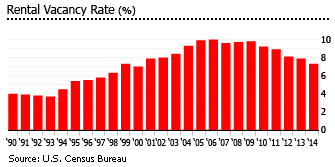
In the second quarter of 2015, the nationwide rental vacancy rate was 6.8%, down from 7.1% the previous quarter, and down from 7.5% in Q2 2014, according to the U.S. Census Bureau.
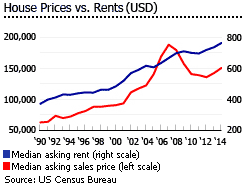
The West had the lowest rental vacancy rate of 4.9% in Q2 2015, followed by the Northeast (5.4%), and the Midwest (7.7%). The South had the highest rental vacancy rate of 8.4% in Q2 2015.
From 2008 to 2014, house prices fell deeply, while median rents were more or less static, according to the U.S. Census Bureau - and since then, rents have risen at least as fast as prices.
High house prices mean that the homeownership rate is falling
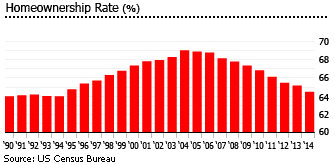
Homeownership has been falling for almost a decade in the U.S., due to rising property prices and tight credit standards. Homeownership was down to 63.5% of households in the second quarter of 2015, from a peak of 69% in 2004, according to the U.S. Census Bureau.
Unemployment is at a seven-year low
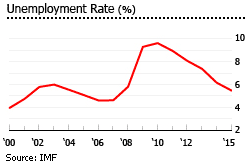
In July 2015, unemployment in the U.S. was 5.3%, according to the Bureau of Labor Statistics (BLS) - a seven-year low reached in June 2015, down from the 6.2% unemployment rate the previous year. The country added around 215,000 jobs in July 2015, mostly in financial services, retail trade, professional and technical services, and health care.
Analysts see a possible US interest hike in September. In June 2015, the Federal Reserve raised its labour market assessment, stating that the labour market continue to "improve, with solid job gains and declining unemployment".
“With the Fed’s decision on the timing of the first rate rise being ‘data dependent’, today’s report does nothing to discourage the belief that a September hike is very much on the table, albeit by no means a done deal," said Markit’s chief economist Chris Williamson.
The country’s unemployment rate averaged 5% from 1998 to 2008. Its recent peak year was 2010 with 9.6% unemployment.
In July 2015, average weekly earnings increased by 2% from the same period last year, to US$860.78.
Economic growth will be moderate in 2015
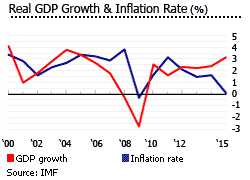
The world’s largest economy accelerated in Q2 2015, with GDP rising by 2.3% y-o-y. This signaled a rebound from the first quarter´s weak growth of 0.6% y-o-y. The second quarter´s fast-paced expansion was fueled by private consumption, and an improving labour market.
The U.S. economy expanded by 2.4% in 2014, 2.2% in 2013, 2.3% in 2012, 1.6% in 2011, and 2.5% in 2010, according to the International Monetary Fund (IMF).
The economy is expected to continue with moderate growth, with a predicted 1.8% to 2% growth in 2015 and 2.4% to 2.7% growth in 2016, according to the Federal Reserve’s June 2015 Federal Open Market Committee (FOMC) meeting. Meanwhile, the IMF recently reduced its GDP projection for 2015 from 3.1% to 2.5%.
This full-year’s budget deficit will likely be the lowest deficit in eight years, with an estimated year-end total of around US$ 425 billion or 2.4% of GDP, down from US$ 483 billion or 2.8% of GDP in 2014, according to the Congressional Budget Office (CBO) - and down from 10.1% of GDP in 2009.
Inflation is expected to fall to 0.1% in 2015.